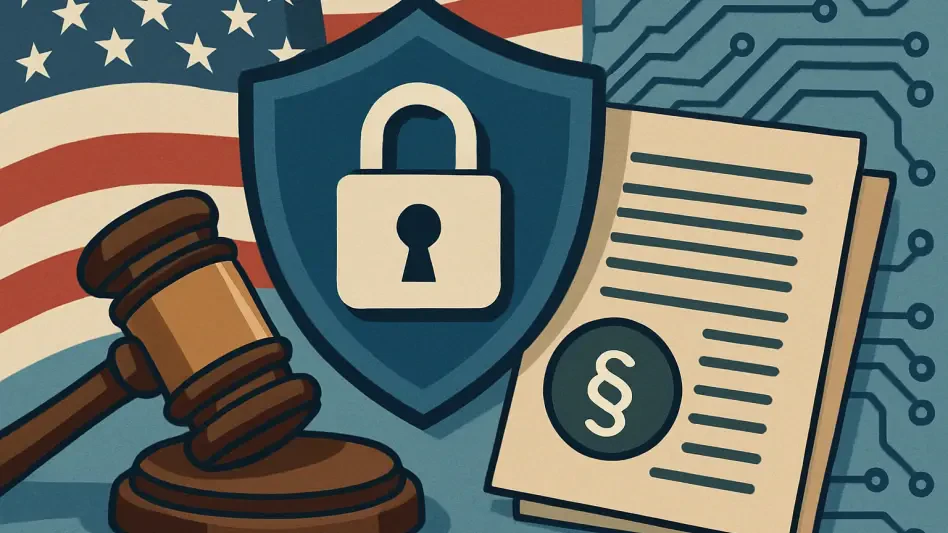In an era where cyberattacks can cripple national infrastructure in mere seconds, the urgency to fortify digital defenses has never been more apparent, especially when considering that a single breach in a government system could expose sensitive data, disrupt critical services, and undermine public trust—all orchestrated by adversaries thousands of miles away. This looming threat underscores the vital role of legislative action in safeguarding the United States against an ever-evolving array of cyber risks. As technology advances with tools like artificial intelligence reshaping the battlefield, Congress faces the daunting task of staying ahead of sophisticated threats while protecting individual freedoms. This summary delves into recent legislative efforts to bolster cybersecurity, highlighting their significance in maintaining national security and resilience.
Addressing the Evolving Cybersecurity Landscape
The digital realm is transforming at a breakneck pace, necessitating updates to foundational cybersecurity laws to keep up with new challenges. A central focus of current legislative efforts is the renewal and modernization of key statutes, such as the Cybersecurity and Information Sharing Act (CISA) of 2015, to address gaps in protection. These updates aim to equip agencies with the tools needed to counter advanced threats that exploit emerging technologies.
Among the pressing challenges are the rapid adoption of artificial intelligence, which can be wielded both as a defensive asset and a weapon by malicious actors. Additionally, the sophistication of cyberattacks continues to grow, with state-sponsored hackers and criminal networks deploying intricate strategies. Congress must also navigate the delicate balance between enhancing security measures and preserving privacy rights, ensuring that protective policies do not overreach into personal liberties.
This evolving landscape demands a proactive stance, as outdated frameworks risk leaving critical systems vulnerable. Legislative bodies are thus prioritizing adaptability, seeking to anticipate future risks rather than merely reacting to past breaches. The stakes are high, as failure to address these dynamics could jeopardize not just government operations but also the broader digital economy.
Legislative Context and National Importance
Recent actions by the House Homeland Security Committee reflect a concerted effort to strengthen the nation’s cybersecurity posture through targeted bills. These legislative moves signal a recognition of the urgent need to protect vital infrastructure, government networks, and sensitive data from escalating threats. The committee’s work underscores a commitment to addressing vulnerabilities that could have far-reaching consequences if exploited.
The bipartisan nature of these efforts highlights cybersecurity as a unifying priority transcending political divides. National security hinges on robust digital defenses, as breaches can disrupt everything from power grids to election systems, impacting both public safety and democratic integrity. This consensus emphasizes that safeguarding cyberspace is not just a technical issue but a fundamental aspect of governance and societal stability.
Moreover, these initiatives resonate beyond federal agencies, influencing state and local levels where resources for cybersecurity are often limited. By reinforcing protections across all tiers of government, Congress aims to create a cohesive shield against attacks that target the weakest links. This comprehensive approach acknowledges the interconnected nature of modern systems and the cascading effects a single failure can trigger.
Key Legislation and Policy Updates
Renewal of Core Cybersecurity Programs
A cornerstone of recent legislative progress is the extension of the Cybersecurity and Information Sharing Act through a new bill titled the Widespread Information Management for the Welfare of Infrastructure and Government Act. This measure secures the act’s provisions for another decade, ensuring continuity in critical information-sharing mechanisms between government and private entities. Such longevity provides a stable foundation for ongoing collaboration in threat detection and response.
Complementing this renewal is the Protecting Information by Local Leaders for Agency Resilience Act, which extends the State and Local Cybersecurity Grant Program for an additional 10 years from now. This program plays a pivotal role in empowering regional authorities to bolster their digital defenses with federal support. By sustaining funding and resources, the legislation helps smaller jurisdictions address vulnerabilities that might otherwise be exploited as entry points for broader attacks.
These extensions reflect a strategic focus on maintaining proven frameworks while adapting them to current needs. Long-term commitments to such programs ensure that cybersecurity efforts are not disrupted by short-term budgetary or political shifts. This stability is essential for building trust and capacity across diverse sectors and levels of governance.
Modernizing for Emerging Threats
Beyond renewals, legislation is being updated to tackle cutting-edge challenges posed by technological advancements. Provisions promoting secure adoption of artificial intelligence stand out, aiming to harness its potential while mitigating risks of misuse by adversaries. New legal definitions for cyber threats are also introduced, providing clarity and flexibility to address novel attack methods that defy traditional categorizations.
Specific measures target niche but critical risks, such as the use of AI by terrorist groups and vulnerabilities in pipeline infrastructure. Mandates for annual evaluations of how extremists leverage technology ensure that policies remain relevant to emerging dangers. Similarly, enhanced authority over pipeline cybersecurity addresses a sector often overlooked yet vital to national energy security.
These forward-thinking updates demonstrate an intent to preempt risks rather than merely respond to them after the fact. By embedding adaptability into legal frameworks, Congress seeks to stay ahead of a digital environment where threats evolve daily. This proactive mindset is crucial for protecting systems against adversaries who continuously refine their tactics.
Balancing Security and Privacy
A key aspect of the renewed legislation is the integration of stronger privacy protections alongside security enhancements. Recognizing public concerns about surveillance and data misuse, these bills incorporate safeguards to prevent overreach while still enabling effective threat mitigation. This dual focus aims to maintain public confidence in government cybersecurity initiatives.
The committee’s approach reflects a nuanced understanding that robust defense mechanisms must not come at the expense of individual rights. Striking this balance involves meticulous crafting of policies to ensure that data sharing and monitoring are conducted transparently and within strict boundaries. Such measures are designed to address past criticisms of cybersecurity laws perceived as infringing on personal freedoms.
This balanced strategy is not just a legal necessity but also a practical one, as public support is vital for the success of cybersecurity programs. By prioritizing both protection and privacy, the legislation seeks to create a sustainable model that can withstand scrutiny and adapt to societal expectations. The emphasis on equilibrium sets a precedent for future policy-making in this domain.
Reflection and Future Directions
Reflection on Legislative Progress
The House Homeland Security Committee’s recent actions showcase a comprehensive strategy that blends continuity with innovation in cybersecurity policy. Extending foundational programs like CISA ensures a steady base, while updates for modern threats like AI demonstrate a readiness to tackle new frontiers. This dual approach highlights a deep awareness of both immediate needs and long-term challenges.
However, sustaining this momentum requires ongoing bipartisan cooperation, which can be tested by shifting political priorities. Additionally, the rapid pace of technological advancement poses a risk of rendering even recent updates obsolete if not regularly revisited. These hurdles underscore the importance of vigilance and flexibility in legislative efforts to maintain effective defenses.
The committee’s work thus far serves as a benchmark for addressing complex issues in a dynamic field. Yet, the complexity of cyber threats means that no single set of laws can fully eliminate risks. Continuous evaluation and adjustment of these policies will be necessary to ensure they remain relevant and impactful over time.
Future Directions
Looking ahead, there is a clear need for deeper investment in research focused on AI security to better understand its implications for both defense and attack strategies. Expanding collaboration with state and local governments can further strengthen grassroots-level protections, creating a more resilient national network. Regular updates to legal frameworks will also be essential to keep pace with unforeseen technological shifts.
Unanswered questions persist about how technologies beyond AI might shape future threats, such as quantum computing or advanced biometrics. The long-term effectiveness of current privacy measures also remains uncertain, particularly as data collection grows more pervasive. Addressing these gaps will require sustained dialogue among policymakers, technologists, and civil society.
Further exploration of international partnerships could enhance global cybersecurity norms, given the borderless nature of digital threats. Developing adaptive funding models to support emerging needs without bureaucratic delays is another area for growth. These steps can help build a more robust and responsive system capable of anticipating the next generation of challenges.
A Unified Push for Cybersecurity Resilience
The recent legislative strides made by the House Homeland Security Committee mark a pivotal moment in fortifying national cybersecurity through extended funding, modernized regulations, and targeted protections against diverse threats. These efforts address immediate vulnerabilities while laying groundwork for future adaptability, reflecting a strategic blend of urgency and foresight. By prioritizing both security enhancements and privacy safeguards, the initiatives achieve a delicate balance critical to public trust and systemic integrity.
Moving forward, actionable steps include fostering greater public-private collaboration to share real-time threat intelligence and investing in workforce development to build a pipeline of skilled cybersecurity professionals. Establishing regular policy review cycles could ensure that laws evolve alongside technology, preventing obsolescence. These measures, coupled with a commitment to international cooperation, position the United States to navigate the complexities of the digital age with greater confidence and resilience.








